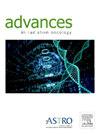非小细胞肺癌脑转移(BM)患者立体定向放射手术后放射性坏死的放射基因组学深度集成学习模型
IF 2.7
Q3 ONCOLOGY
引用次数: 0
摘要
目的立体定向放射手术(SRS)被广泛应用于脑转移瘤(BM),但放射坏死的风险对SRS后的治疗提出了挑战。鉴于缺乏区分放射性坏死和复发的无创成像方法,我们旨在设计一个深度集成学习模型,该模型整合了患者的临床特征和基因组谱,以识别srs后放射学进展的BM患者的放射性坏死。方法和材料我们研究了62例非小细胞肺癌患者的90例脑转移,其中27例活检证实srs后局部复发。收集临床特征和分子特征。使用srs后3个月T1+c磁共振成像训练深度神经网络(DNN)进行放射性坏死/复发预测。在二值预测输出之前,将潜在变量提取为1024个深度特征。然后开发了一个集成学习模型,包括2个子模型,将深度特征与临床(“D+C”)或基因组(“D+G”)特征融合在一起。我们采用位置编码方法将低维临床/基因组特征与高维图像特征进行最佳融合。每个子模型中的融合后特征在遍历全连通层后产生logit结果。集成的最终输出是这两个子模型的逻辑经过逻辑回归的综合结果。模型训练采用8:2训练/测试分割,并开发了10个模型版本用于鲁棒性评估。将性能指标与仅图像DNN模型和“D+C”和“D+G”子模型进行比较。结果深度集成模型在测试集上表现良好,受试者工作特征曲线下面积(ROCAUC) = 0.91±0.04,灵敏度= 0.87±0.16,特异性= 0.86±0.08,准确度= 0.87±0.04。这明显优于仅图像的DNN结果(ROCAUC = 0.71±0.05,灵敏度= 0.66±0.32)。与“D+C”结果(ROCAUC = 0.82±0.03,灵敏度= 0.67±0.17)和“D+G”结果(ROCAUC = 0.83±0.02,灵敏度= 0.76±0.22)相比,平均性能也有所提高。结论在本研究评估的模型中,深度集合模型在区分脑脊髓瘤放射性坏死与复发方面表现最佳,该模型使用了srs后3个月的T1+c MR图像、临床特征和基因组特征。这突出了人工智能在BM管理临床决策中的潜力,值得进一步研究其临床应用。本文章由计算机程序翻译,如有差异,请以英文原文为准。
A Radiogenomic Deep Ensemble Learning Model for Identifying Radionecrosis Following Brain Metastases (BM) Stereotactic Radiosurgery in Patients With Non-small Cell Lung Cancer BM
Purpose
Stereotactic radiosurgery (SRS) is widely used for brain metastases (BM), but the risk of radionecrosis poses a challenge in post-SRS management. Given the lack of noninvasive imaging methods for distinguishing radionecrosis from recurrence, we aimed to design a deep ensemble learning model that integrates patient clinical features and genomic profiles to identify radionecrosis in patients with BM with post-SRS radiographic progression.
Methods and Materials
We studied 90 BMs from 62 patients with non-small cell lung cancer, with 27 biopsy-confirmed post-SRS local recurrences. Clinical features and molecular features were collected. A deep neural network (DNN) was trained for radionecrosis/recurrence prediction using the 3-month post-SRS T1+c magnetic resonance imaging. Preceding the binary prediction output, latent variables were extracted as 1024 deep features. An ensemble learning model was then developed, comprising 2 submodels that fused deep features with clinical (“D+C”) or genomic (“D+G”) features. We employed our positional encoding method to optimally fuse the low-dimensional clinical/genomic features with the high-dimensional image features. The postfusion feature in each submodel yielded a logit result after traversing fully connected layers. The ensemble's final output was the synthesized result of these 2 submodels’ logits via logistic regression. Model training employed an 8:2 train/test split, and 10 model versions were developed for robustness evaluation. Performance metrics were compared against image-only DNN model and “D+C” and “D+G” submodels.
Results
The deep ensemble model showed satisfactory performance on the test set, with the area under the receiver operating characteristic curve (ROCAUC) = 0.91 ± 0.04, sensitivity = 0.87 ± 0.16, specificity = 0.86 ± 0.08, and accuracy = 0.87 ± 0.04. This significantly outperformed the image-only DNN result (ROCAUC = 0.71 ± 0.05, sensitivity = 0.66 ± 0.32). Higher average performance was also observed compared to the “D+C” result (ROCAUC = 0.82 ± 0.03, sensitivity = 0.67 ± 0.17) and “D+G” result (ROCAUC = 0.83 ± 0.02, sensitivity = 0.76 ± 0.22).
Conclusions
The deep ensemble model achieved the best performance among the models evaluated in this study for distinguishing BM radionecrosis from recurrence using 3-month post-SRS T1+c MR images, clinical features, and genomic features. This highlights the potential of artificial intelligence in clinical decision-making for BM management, warranting further investigation into its clinical applications.
求助全文
通过发布文献求助,成功后即可免费获取论文全文。
去求助
来源期刊

Advances in Radiation Oncology
Medicine-Radiology, Nuclear Medicine and Imaging
CiteScore
4.60
自引率
4.30%
发文量
208
审稿时长
98 days
期刊介绍:
The purpose of Advances is to provide information for clinicians who use radiation therapy by publishing: Clinical trial reports and reanalyses. Basic science original reports. Manuscripts examining health services research, comparative and cost effectiveness research, and systematic reviews. Case reports documenting unusual problems and solutions. High quality multi and single institutional series, as well as other novel retrospective hypothesis generating series. Timely critical reviews on important topics in radiation oncology, such as side effects. Articles reporting the natural history of disease and patterns of failure, particularly as they relate to treatment volume delineation. Articles on safety and quality in radiation therapy. Essays on clinical experience. Articles on practice transformation in radiation oncology, in particular: Aspects of health policy that may impact the future practice of radiation oncology. How information technology, such as data analytics and systems innovations, will change radiation oncology practice. Articles on imaging as they relate to radiation therapy treatment.
 求助内容:
求助内容: 应助结果提醒方式:
应助结果提醒方式:


